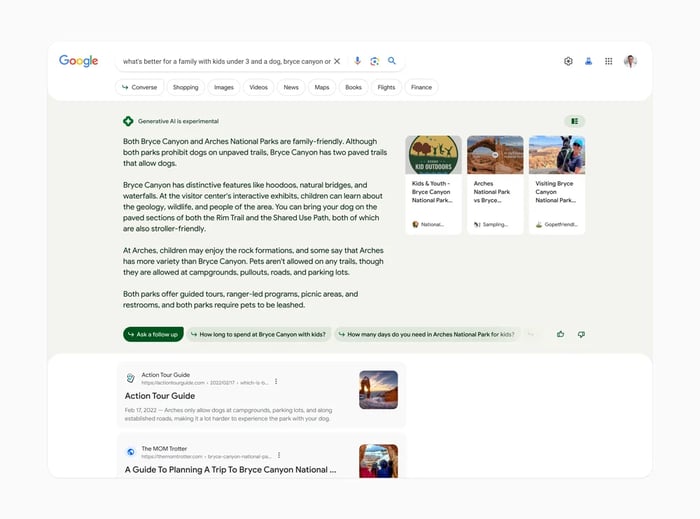Just when you think you've finally got a grasp on current SEO and how to rank on Google, they announce a massive change that will dramatically redefine how people search online and how results are generated. While it's a pain for everyone, I guess it does offer our team job security!
Google's search generative experience is on the way, and it's a drastic departure from traditional search and content creation. Here's what you need to know if you rely on search as part of your business development and lead-gen.
What is Google's Search Generative Experience (SGE)?
Before I continue, it's important to note: SGE currently has no anticipated launch date and is in active development. Below is the latest information from Google, but it may change as the technology is developed and launched.
SGE is a completely new way of presenting content and interacting with Google. From a user perspective, the biggest difference you'll notice with Google's SGE is how you engage with results.
Results will display AI-generated text snippets right within Google and prompt users to interact further with the content - they'll be invited to ask follow-up questions or potentially take an action like purchasing a product from search.

As demonstrated in the screen capture, searching for a query pulls text into the search engine results page (SERP) with the additional prompt: "ask a follow-up."
This represents a massive shift in how users will engage with Google that you may have already noticed: it's no longer necessary for users to click on links and leave Google.
Instead, users will be able to execute a majority of their actions right within Google. Even current Google technology that displays some content in the SERP still requires users to visit the site to read more or take action - this update will make that unnecessary.
To see SGE in action, check out Google's announcement video:
Related Content: What You Need to Know About Google's AI Search Update
How to Adapt Your Content to Prepare for SGE
While SGE is still in development, there are a few actions you can take now to prepare for the future of search.
You need a clear buyer persona and journey for each piece of content
Google's updates seek to do one thing: deliver the exact results that each individual user wants to see. Under this new model, search results from a user perspective will feel more accurate, proactive and predictive.
For businesses and marketers, this means that having a clearly defined persona and journey behind each piece of content is vital. As a quick refresher, a persona is a fictionalized representation of an ideal customer. Their buyer's journey is the path they take from prospect to sale.
For content creation purposes, you need to know how the persona problem-solves online. What's their move? Let's take an example where two personas are looking for a cabin rental for a family reunion.
- Persona A: Asks relatives and friends for recommendations, then searches specific resort names online. While searching, they may click on ads or other results in SERP.
- Persona B: Searches through Instagram for photos of cabins in desired (state). They then look up resort names on sites like Airbnb and Vrbo.
They both have the same need, but take different paths in their search. Other factors to consider are how they consume content (on their phone during work, on desktop at home), what length and type of content resonates best (ex: short videos or long blog posts) and what stage they are at in their journey (are they ready to buy NOW, or still doing research?).
Each piece of content should be aimed at one persona and at each stage in their journey. This means you might produce content for the same persona that aims to inform and additional content that aims to conduct a transaction.
Search intent optimization >> search engine optimization
This new update is directly aimed at anticipating and addressing a user's search intent, versus the specific keywords they use to execute that search.
Intent digs into the underlying motivations of why someone is searching. Intent is generally broken down into the following categories:
- Informational intent searches are based on gathering information, both basic and complex. In this type of search, people have a specific question or want to know more about a certain topic.
- Navigational intent searches help searchers find an actual website. For example, searching "Facebook" into Google to find pics of their grandkids or see what their college buddies are doing on, ya know, Facebook.
- Transactional intent searches focus on retail or eCommerce. These are searches intending to buy a specific product, like "high waisted jeans" or "cheap sunglasses."
- Commercial intent searches help find future purchases. People may know they need a larger item in the future and want to do research online before purchasing.
Have a clear picture of intent behind your content when you write it. For example: a guide to SEO could be informational (a user looking to do SEO themselves), transactional (a business looking hire an SEO agency) or commercial (a business looking to hire an SEO employee).
Lean into personality and identity
AI has drastically increased content output - but largely, it's low-value, "samey" content. Plus, many businesses purposefully use a neutral, professional tone in their content. Combined, these mean that there's a ton of generic content for every variation of every topic and niche.
To stand out, your content needs to provide more value. As a human and as a business, your brand can provide perspective, bias and complexity. That sentence may have made you balk - traditionally, advice for businesses producing content has been to stick to that neutral, universally appealing tone and avoid a strong identity to avoid alienating an audience. But now with an unprecedented level of new content being pumped out every day, an identity is exactly what will set your content apart.
Developing an identity and a tone can be authentic. The easiest approach is to use content from your brand's thought leaders and give them the freedom to write in their voice. This doesn't mean you should blast out content without internal review, but you can worry less about ensuring content is all written in the same branding tone and more about whether it's interesting. Look to your buyer personas when developing voice: they likely have tone preferences that resonate with them.
Google's SGE isn't here yet - but it's a good idea to get ahead of the competition by preparing for it now. Tailoring your content to a highly specific niche with identity-driven content is the best way to rank in this highly competitive landscape.
Free Download: Everything You Ever Wanted to Know About Inbound Campaigns
Content is critical, and the best way to create compelling content is by providing value. Inbound campaigns help you find, target, and convert your ideal audience. Click "get my eBook" below to learn how to create buzz-worthy Inbound campaigns that drive action.
BizzyWeb is a Minneapolis-based digital marketing and web design agency that helps companies get the high-quality leads they need to grow and thrive. Our tactics include inbound marketing, SEO, advertising, web design, content creation and sales automation. We are an accredited HubSpot Platinum Partner and we offer full-service HubSpot onboarding, enablement and strategy for new and current users.






